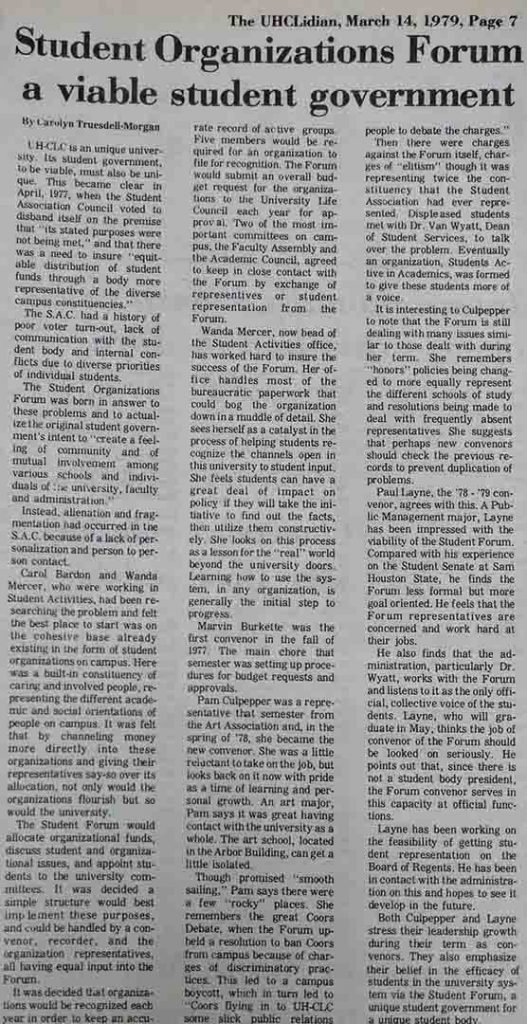Retrospection: Student government transitions over the years
In the spring of 1977, the UHCL Student Association Council (SAC) voted to disband itself. The SAC stated at the time that the student government was not fulfilling its purpose and was reported on March 14, 1979, that there was a need to ensure “equitable distribution of student funds through a body more representative of the diverse campus constituencies.”
Prior to disbanding, the SAC had a history of low voter turn-out, lack of communication with the student body and internal conflicts due to diverse priorities of individual students. Alienation and fragmentation dissuaded student involvement, leading the council to seek change. Their solution at the time was to build a student government out of the existing student organizations on campus. These groups contained a built-in constituency of involved people and represented the varied academic and social orientations of the student body.
The Student Organizations Forum (SOF) was the best solution at the time and was implemented following the disbandment of the SAC. Its purpose as reported in 1979 was to “create a feeling of community and of mutual involvement among various schools and individuals of the university, faculty and administration.”
The duties of the SOF included allocating funds to student organizations, discussing issues affecting students and organizations and appoint students to university committees. The structure of the SOF was kept minimalist so as not to bog down progress and discussion. In its original state, forums consisted of a convenor, a recorder and elected representatives from each of the student organizations. Eventually, the SOF was amended to include an Executive Council of four members: the President, the Vice President – Committee Coordinator, the Vice President – Outreach and Communication, and the Vice President – Administration. The SOF also included six directors who would assist and advise the Executive Council on external affairs, internal affairs, public relations, special events, technology and treasury.
This system was not without its own issues. In 1979 the SOF was charged with elitism and failure to represent broader student interests. This was rectified at the time with the formation of the Students Active in Academics organization, which has since ceased.
The SOF transitioned into the Student Government Association (SGA) March 4, 1997, attempting to formalize and rectify some of the issues it faced over the course of its history. However, the same issues plagued it – low voter turnout and charges of elitism among the most prevalent. The SGA amended its constitution Oct. 11, 2016, to allow the right to vote for its Executive Council members to all students. Previously, less than 1 percent of the UHCL student body was able to vote. With a population of 8,669 students enrolled during the 2016 fall semester, the Executive Council was previously elected via the 93 Student Organization Representatives.
The student government of UHCL has always had an issue with communication and student outreach. Even with the opening of voting for the Executive Council in 2016, the following election saw just one student out of the 8,669 who applied for a seat.
Last year former SGA President AJ Johnson proposed changing the SGA constitution once more to establish a student senate modeled after similar senates found nationwide.
“The benefits a senate brings to campus are greater awareness of SGA, better information dispersion to students, quicker/better knowledge of student issues through surveying by the senators and a unified student voice,” Johnson said in a February 2018 article by The Signal.
That amendment passed after a long summer of negotiations and debates determining who would be eligible for election to the SGA Senate and what their duties would be. The 25-member senate was established to enhance the SGA by allowing it to field more academic issues than before. Ideally, the student senate will help alleviate the issues that previous student governments have suffered.
Student senator responsibilities include surveying students, liaising between students and their respective colleges, meeting with college faculty members to discuss student needs, attending SGA meetings every Tuesday and attending senate meetings that will occur one Thursday a month. Applicants must have a cumulative 3.0 GPA or higher and plan to be enrolled at UHCL until spring of 2019.
Election voting for the Executive Council will run from March 20 to March 26, and election voting for the student senate will run from March 27 to April 2. Hopefully this time SGA will promote their elections, alleviating at least the pervasive issue of low voter turnout. As to whether this will enhance student involvement in their representative government, only time will tell.

Also published on Medium.

